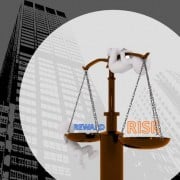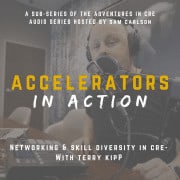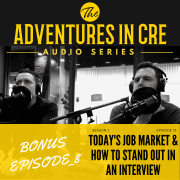How to Quickly Evaluate Real Estate Opportunities (Without Opening Excel)
We regularly respond to questions from A.CRE and Accelerator members as it relates to analyzing and evaluating real estate investment opportunities. Recently, in an Accelerator forum post a young professional marveled at how certain individuals in his office could look at a deal and within a matter of minutes make an assessment as to whether the deal was worth spending more time on. He asked if we had any insights into how that was possible.
In this episode of the A.CRE Audio Series, Spencer, Michael and Sam discuss back-of-the-envelope analysis. They discuss specific techniques for quickly getting to a decision as to whether to dig deeper, or move on from a deal. And they share insights from their personal experience, having collectively underwritten over $30 billion of real estate in their careers.
Are you an Accelerator member?Read the forum thread that led to this A.CRE Audio Series Episode. Not yet an Accelerator member? Consider joining the real estate financial modeling training program used by top real estate companies and elite universities to train the next generation of CRE professionals.
How to Quickly Evaluate Real Estate Opportunities (Without Opening Excel)
Watch as Spencer, Michael, and Sam discuss specific techniques for quickly evaluating a real estate investment (i.e. back-of-the-envelope analysis).
Resources from this Episode
- A.CRE Real Estate Financial Modeling Accelerator
- CRE Career Advice
- Analyzing Value-Add Investments in CRE
Episode Transcript – How to Quickly Evaluate Real Estate Opportunities (Without Opening Excel)
Announcer (00:04):
Welcome to the Adventures in CRE Audio Series. Join Michael Belasco and Spencer Burton as they pull back the curtain on everything commercial real estate, and introduce you to some of the top minds in the industry. If you want to take your skills to the next level and be part of a growing community of CRE professionals across the world, this is for you.
Michael Belasco (00:28):
Hello, and welcome back to the Adventures in CRE Audio Series. So, I know we call it an audio series and primarily that’s because we used to record these in seasons. But due to COVID, this is almost becoming a podcast now. So today we have a really cool episode. It comes from the context of what we do day to day in Adventures in CRE. And to queue this up, I’m going to turn it over to Spencer to tell us what we’re talking about and how we can help you guys learn more about ACRE and what it means to you guys.
Spencer Burton (00:59):
Yeah. Yeah. So we get emails all day long and we love those. And a lot of them are really interesting questions around careers, and modeling, and the like. We’ve got a question in this week, actually came in through our Accelerator forum. And this particular individual asked about … Well, first off, he shared that in his office, there are certain more senior folks who they have just this innate ability, and he works in a value add shop, this innate ability to quickly assess a deal and either pass on it or say, “Yeah, this is worth spending some more time on.”
Spencer Burton (01:39):
And he was asking like, “What are some tricks to get there?” And so that’s what really this audio episodes about. We’re going to talk specifically about back of the envelope, quick and dirty value added investment analysis. But it can really relate to any tricks, Michael, me, Spencer, any tricks that we’ve learned over the years that helps us quickly assess the viability of the deal and either move on or spend more time on that.
Spencer Burton (02:13):
So let’s start actually with Michael. In your experience, in the various value add, or even development deals, because I think it relates there as well, what have you learned as a way that you can quickly look at a deal, assess it, and either pass on it, or know that it’s a deal we’re spending more time on?
Michael Belasco (02:34):
Yeah, I think it boils down to … Or first understanding the market. You have to have a baseline, right? Knowing the market. So what deal you’re looking at. If it’s a value add deal in particular, you need to know what that opportunity would look like at stabilization. And so, you’ll look at some very baseline metrics. You’ll look at what a typical NOI would be today, or in looking at it when you’re evaluating it, that would be the cap rate on year one.
Michael Belasco (03:07):
So you would look at it as a baseline. What would you pay? What would be the cap rate you would pay? And then you think about, “Okay, what would this building take to stabilize? What would you need to do to bring it up to market, or to bring it up to what we would call maybe a core? How much would that cost roughly? And then back out to what you would pay for that. And then you would look at basically really the spread, right, which we would call, and Spencer, I’ll let you dive into the details, a yield on cost, compare that roughly to a cap rate.
Michael Belasco (03:37):
And there’s a couple more nuances we’ll get into, but that’s really just if you know your market, you know the asset type, then you should be able to relatively easily at a high level, back in the envelope, back of the napkin methodology in your head be able to get to an answer now. There’s a couple more nuances to that, but that is how you can really get to it in your head. It’s not having this deep seated experience. It’s just knowing the market, knowing some basic math and really getting to think about at a high level. So I’ll stop there and kick it over to you, Spencer, to get a little bit more of the details or give us your thoughts as well.
Spencer Burton (04:12):
Yeah. And I think even stepping back before that, I think understanding your box is the first step to quickly assessing deals, right? So some of it is simple. If you invest in office buildings, then you don’t look at hotel, right? I mean, it literally is that simple. I call it a filter, whatever you want to call it, but you’ve got a box that you live in, and it may be the shop that you’re working at, or may be your own personal strategy. And by the way, if you don’t have a box, your life gets very, very difficult because then you don’t know what to look at and what not to look at.
Spencer Burton (04:49):
So it starts with that box. And as soon as you have that box, you get to know exactly, and this is to Michael’s point, you get to know that box. And so let’s come back to office as an example, right? It’s like, what type of office am I looking at? Am I looking at suburban? Am I looking at CBD? What markets am I my looking at? And again, it’s a filter to a certain extent. It’s like, “Hey, this is the box I’m in.”
Spencer Burton (05:12):
And so you can quickly, as deals begin coming in, you can filter for those elements that are the most obvious. And so the first answer to the question, how does some of these guys and girl quickly sift through? Some of us, just take a look. They know that it’s in Indianapolis and we don’t do office deals in Indianapolis and it’s that simple. The next piece of it though, is the analysis piece.
Spencer Burton (05:37):
So let’s imagine it is in a market that’s of interest and it is the profile. Maybe it’s the age, maybe it’s you’re looking at suburban deals. You’re only looking at multi-tenant, and you’re looking in these certain markets. And it checks all those boxes. And those are easy, easy boxes to check. At that point, then it gets to Michael’s piece, which is the actual financial analysis. And the point that was raised by this particular reader is that, how can you do that without pulling out an Excel, running full DCF, looking at the IRR, saying, “Yes, this is an IRR”? And unlevered IRR of an eight, and that’s what we expect. How do you do that?
Spencer Burton (06:16):
And that’s where the concept of yield on cost compared to market cap rate comes. In development, we call that a development spread. In value add, I call it an investment spread. Everyone has a slightly different term for it. But really it’s that spread between the yield that you can earn that stabilization on your costs compared to the market cap rate for an otherwise stabilized building. And doing that math is actually pretty simple. It doesn’t take opening Excel. It doesn’t even take a napkin and a pen and paper in a lot of cases. So yeah.
Sam Carlson (06:53):
[inaudible 00:06:53] just a little bit and see if maybe … Just to deconstruct the problem just a little bit. Potentially, is one of the issues. It seems like you talked about a lot of different scenarios, right? There were instances [inaudible 00:07:12] talking about different types of transactions and, of course, if you start here then here. And you talked about a box. Is the underlying problem that most of the time people potentially look at too broad of a spectrum of transactions? And the best way to start getting this it’s almost like an intuition. It’s a feel for those is to pick one specific niche and get that dialed in? And then maybe be able to model that to the others. Are we having a problem because we’re going too big?Michael Belasco (07:48):
I would say a little bit, maybe Spencer, you would agree to that.
Spencer Burton (07:51):
We disagree on this point. But yeah, [inaudible 00:07:53].
Sam Carlson (07:53):
Did I just stir up the [inaudible 00:07:55].
Michael Belasco (07:55):
No, no. I think the problem is people overthink it. I’ve overthink things for years, right? I mean, you come around to realizing when you talk to people that become your mentors and people that have become really successful in the industry, and you hear them talk, you start to hear them think, and it comes down to very basic math. And we go really deep. So it’s almost like there are a lot of people that I know that are in many asset classes, in many markets and that’s a knack. They understand value, right? It goes water. That’s where Spencer and I have a little bit of a disconnect.
Michael Belasco (08:33):
But when people ask, “How do I do this quickly?” It’s like, how much do I have to memorize how much I have to cram in my head to be able to know it. To me, there’s a gift in the simplicity of it. If you can figure out, boil it down to what really matters, do some math. This is stuff that took me years to learn. I mean, I’m recently learning all this stuff about how to boil it down to the basic points, right? Real estate. What do you have to know? Equity, multiple IRR, all these need Excel to do for you. And in a lot of ways, it comes down to the simple, simple formulas and simple math that helps you get to the back of the envelope answer. And then you go and you underwrite it and maybe you’re off by 1% or 2% or [inaudible 00:00:09:17]. Yap.
Sam Carlson (09:18):
So are you saying that the problem is … What are you saying? Because-
Michael Belasco (09:25):
I’m saying, when you look at a big real estate investment or small real estate investment, you’re trying to match up these metrics, which are important to know, and you need Excel for it, right? And so, to me, and maybe this is different for some people, you start with the process and you need to get this really … You need to get in depth and you need to get a good answer. Even when you’re doing a first round underwriting, you got to throw it in a proforma.
Michael Belasco (09:48):
In the Accelerator, Spencer’s first course, right? Direct cap. It hits on that. So to me, it’s understanding when you’re doing it in your head, it’s getting the simple math. What are the simple go-to math equations I need to do? Right? To meet in your head it’s take the cap rate against the yield on cost. That’s the first thing, right? And what does it roughly cost? What’s valid per square foot? What are we building cell phones market? These are not complex math problems. They’re math, just numbers you need to know in simple formula. I think that answer-
Sam Carlson (10:30):
Let’s switch over to Spencer and see, because this has obviously been a debate between the two of you. So Spencer, your thoughts.
Spencer Burton (10:38):
Well, I was on a little bit of a different topic. Maybe Michael and I weren’t on the same page. So, I was speaking about the box. And Michael’s view, and I hate to put words in his mouth. But we’ve talked to about this to a certain point where I think the words I’m saying are right. Michael’s view is, if you’re opportunistic, you’re somewhat agnostic to location, to property type. It’s like, “Let’s go out and find deals where there’s opportunity.” And I totally get that.
Spencer Burton (11:05):
If I’m new as an investor, okay? And so I’m not working for someone. I’m going to go out and I’m going to do my first investment. I’d like to specialize. And that way I get to know a market and I get to know a property type, and I get to know a niche within that property type. And then once I know that, then I can start broadening that. Michael, on the other hand, I think a lot of people are like him and I celebrate it. If you have that ability to say, “I’m just going to go out and find good deals.” And my issue with that is you spend so much time looking for good deals because you don’t have the ability to sift down to what is your specialty.
Michael Belasco (11:48):
I agree and disagree. And you know, the beauty of your perspective of going deep is that you really know it. It’s almost like your life gets easier. You know? It’s like you get really comfortable and you know, and things you get really deep and you really understand it where when you’re constantly looking all over the place … Spencer, you and I have these conversations just about even in life in general about getting into a direct path and your life gets easier.
Michael Belasco (12:16):
And part of it is like, you learn a lot, but you are scattered and you do need to hone in. It’s just a faster learning curve to me. If you’re going it’s a harder learning curve, if you go and expand in all these direct classes. But there are a lot of people that are very successful that have done that and they’re sparked by their curiosity.
Michael Belasco (12:39):
And just if they find something they’re passionate about is that we’ve had Alex Secaucus on the show. And he’s a guy that capstone advisors where he’s always been, find something that I’m passionate about or something that excites me and go after it and learn about it. He’s had remarkable success. I’ve always looked to that as an aspiration. And that’s not the only way, like you said.
Spencer Burton (13:07):
That’s a good example. I think it takes a personality type. So my mind just doesn’t work that way. So I can’t say the entire world or real estate is my investment strategy and I’m just going to find good opportunities, because I would get so bogged down in the deluge of opportunities that come in. I’d never be able to find the right one. Where if I said, “Okay, I’m only going to look at single tenant industrial under 150,000 square feet in secondary markets on the West United States,” now I’ve got some focus. And then I know which brokers to talk to. I know which properties to spend some time on. And now we can get to actually the math, which Michael presented a little bit. But if you’re interested in the quick and dirty way, let’s take my industrial. If I can go here now, guys, or am I pushing this too fast?
Michael Belasco (14:08):
[crosstalk 00:14:07].Sam Carlson (14:08):
I actually do want to ask one thing before we get into the nitty gritty, because we’ve jumped from spectrum to niche, to spectrum, to niche. And I’m wondering just to maybe give some streamline a little bit of congruency here, both of you, are there some principles and some things that you both would agree, okay, whether you’re in the box or whether you’re being adaptable? Are there some things that at a foundational level, these are the things you need to have down? Like you need to feel really good about these, whatever things? Are there some things that you guys think you agree on there and then-
Michael Belasco (14:48):
We disagree about everything.
Sam Carlson (14:53):
[inaudible 00:14:53] to start from. I guess I’ll hand it over to Spencer first.Spencer Burton (15:00):
Okay. Foundational principles in terms of?
Sam Carlson (15:04):
Well, you’re talking about [inaudible 00:15:06]. Let’s have a place where we can start.
Spencer Burton (15:10):
Yeah. I mean, you need to have rules. That’s important. And the rules of thumb ought to match the market as best they can. And some of those, you just learn over time. You need to have rules of thumb. And that speeds along your underwriting. When you have those, more than likely they’re going to be 90% to 95% right, and that moves you along quicker. And you use those rules of thumb to do this really quick math that we’ll talk about in a second. And then you can move on. Because if not, there are literally hundreds of deals that you could look at every month and not enough time in the day to do the deep analysis that you need to do on every deal.
Sam Carlson (15:49):
Okay. Anything to add to that, Michael?
Michael Belasco (15:53):
Yeah. I just actually was going to ask Spencer. When you say rules of thumb you’re 95% correct, what do you mean by that?
Spencer Burton (15:59):
Yeah, what I mean by that is, so I’m going to use an industrial example in a second. So it might be your TI assumption. Or even simpler than that, the leasing. The total leasing cost. So TI plus leasing commissions as a per square foot for a typical tenant in your market. Right? And so then I can use this as an example. Let’s say that we have an empty industrial building in Salt Lake City. Okay? It’s selling for 100 bucks a foot. It’s a small format kind of last mile building newer, let’s say 27 foot height. That’s probably too high. But anyway, you get the idea. 24 foot clear height, whatever.
Spencer Burton (16:48):
Okay. So 100 bucks a foot and rents in that market for that type of building 10 bucks a foot. Just general rules of thumb, 10 bucks a foot. But it’s empty? Okay. And it’s going to cost you 20 bucks a foot to lease the thing. Okay? So you’re 100 bucks a foot to buy. You’re 20 bucks a foot to lease. And that 20 bucks, a foot includes TIs leasing commissions, carry costs to get you to that point.
Spencer Burton (17:19):
But once you’re there, and let’s assume triple net leases. So that 10 bucks a foot is your NOI. Your yield on cost is 10 divided by 120. So what’s 10 divided by 120? It’s 8.33%. That’s your yield on cost. What could you buy that exact building for today? Or what would the cap rate be for a building like that today fully leased at 10 bucks a foot?
Spencer Burton (17:47):
Let’s say it’s seven, a seven cap. So we’re buying and leasing this up at an eight, three, three yield on cost. We could buy it, the building next door that’s identical to it same credit tenant, same everything at a seven-cap. That means there’s 133 basis points of premium investment spread, divestment spread, whatever you want to call it between this value add opportunity and a core opportunity next door. Is that 133 basis points of premium sufficient to account for the risk and time and cost inherent in taking a vacant building and getting a lease?
Michael Belasco (18:26):
So the security around it. Yeah. Sorry. I thought you were-
Spencer Burton (18:29):
No, so my final point about that, and here’s the math. And in fact, we shared a blog post this last week that provided this match. So I can link to that. But it’s a really, really, really easy analysis to do you already have your box. You’ve got your rules of thumb, which allow you to do this analysis. And then you’ll likely have a rule of thumb that says, “Is that 133 basis points sufficient?” You might say, “Okay, our type of business, we expect 75 basis points for this sort of deal. And here we’ve got more than 75. And therefore, this is a deal that’s worth spending more time on.”
Michael Belasco (19:05):
Yeah. Spencer’s point having the box, right, knowing what the leasing commissions are, those things, when you have a guy in your office who you can just … He’s the senior guy and he knows the stuff like that. I mean, that’s where like, “Oh, you’d have to call brokers. You have to do some research. You have to figure that out without being deep into that.” That’s that piece. I mean, that’s a great. As always, you have these great, simple examples that really illustrate the point. So yeah, no, I think that’s a great example.
Sam Carlson (19:37):
Yeah. So I think as a person listening to this, if you’re thinking, “Hey, I would like to be more proficient at this,” is it as easy as going and finding that person? Because the premise of this topic was that this student or this reader had reached out and had reached out and said, “There’s people in my office that can do this really quick.” Is it as simple as reaching out to those folks and saying, “Hey, listen, there’s a couple of things I’d like to have a conversation and gain some context.” Is it as much as just opening your mouth and getting that relationship building thing and asking, being willing and maybe even vulnerable to ask the questions and find out those niche pieces of information. Is it that simple?
Michael Belasco (20:31):
Yeah, that’s one way. In fact, if you do that with senior people, that shows your level of interest in wanting to engage and improve your self within your career. So I think that’s a fantastic way to go about it. I mean, Spencer, I’m sure you have people coming up to you asking you how to do that stuff. It shows you, “Okay, this is a guy I want working with me and for me because he wants to learn the things that I know and what I’ve done to get to where I am today.” So, yeah, it’s a great, great option.
Spencer Burton (21:03):
Yeah. Yeah. I agree with that. Number one, it helps your career. But that’s how you learn. So deal seasoning is a very real thing. When we talk about deal seasoning, a lot of it is this. Learning the rules of thumb for your area of expertise. And the more deal seasoning you get, the more this is the leasing commission in Las Vegas. We’re a 625 on a new lease in Las Vegas. And I don’t know if that’s the case, by the way. Just throwing that. Whereas in San Francisco, it’s 575. You know, those little tiny things you learn over time, but you can speed along that learning to your guys’ point by asking and engaging with more senior people and showing a genuine interest in learning and developing that seasoning that you need to be able to do this faster.
Sam Carlson (21:56):
Well, that’s great. Well, in conclusion, any final words, anything you want to add to that to summarize? Anything we want to make sure that people just, as far as a takeaway? One takeaway from each of you, I guess?
Michael Belasco (22:10):
For me, I think the big ideas, first this was a conversation around how to do something or how to figure out the cheat sheet to quickly evaluate whether an opportunity is worth it or not at least with the back of the envelope approach. And I think just the higher level concept here is constantly figuring out ways how to get better in learning. Honestly, it’s weird. It almost culminated with your question, Sam, which is what’s a great way to do that and reach out?
Michael Belasco (22:40):
Ask your superiors. Really utilize those people as resources. It’s a great value add. It’s a great way to have conversations and connectivity with them as well. So I know this was not about that, but it culminated into that, which I think is really great. So that’s my last piece of parting advice, so to speak
Spencer Burton (23:00):
Mine is it actually comes from a professor. We had it in grad school who he explained this concept of modeling. Your model is only as good as your inputs. And so you may know how to build a beautiful model. If you don’t actually know the inputs, then there’s no value in … You don’t have much value, I guess, to the process. And so, while real estate financial modeling is key, especially earlier in your career, it’s equally as important to get to know the inputs. Know what goes into … Yeah, you can do quick analysis. But if you don’t actually know what inputs even go into the quick analysis, you won’t be able to add much value. So know your business. Know your trade.
Sam Carlson (23:45):
It seems to me like there is no shortcut. But if we were to give any credence to a quote shortcut, that would be engage others who know. See if you can get some mentorship. See if you can get some credible answers that will help you. Just do better. Make better decisions.
Sam Carlson (24:07):
So thanks you guys. This has been a really fun, informative episode. So thank you listeners, and we’ll see you on the next one.
Announcer (24:17):
Thanks for tuning into this episode of the Adventures in CRE Audio Series. For show notes and additional resources, head over to www.adventuresincre.com/audioseries. Would you like to learn real estate financial modeling in a matter of weeks and do it with zero guesswork? If so, the A.CRE Accelerator is for you. The Accelerator is a step by step case-based program designed to teach you exactly what you need to know, and in the order you need to know it so you can gain both the knowledge and experience to take your career to the next level. To see if the Accelerator is right for you, go to www.adventuresincre.com/accelerator/








